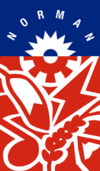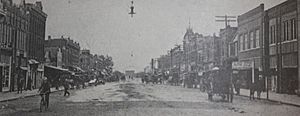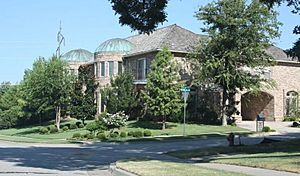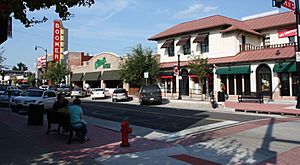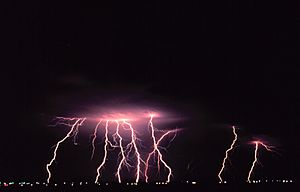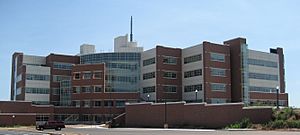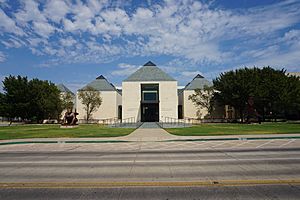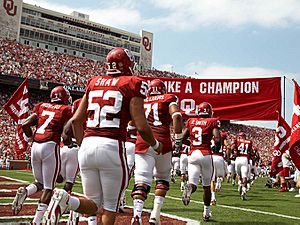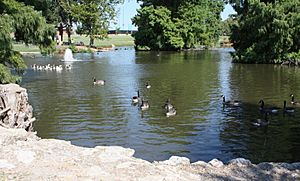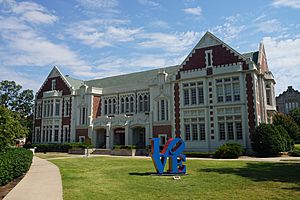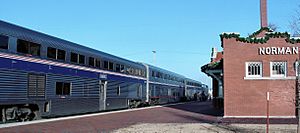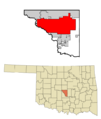Norman, Oklahoma facts for kids
Quick facts for kids
Norman, Oklahoma
|
|||
|---|---|---|---|
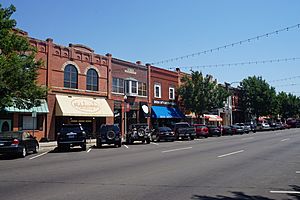
Main Street (2019)
|
|||
|
|||
| Motto(s):
"Building an Inclusive Community"
|
|||
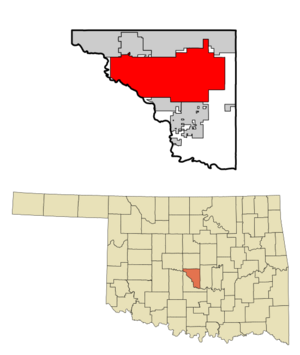
Location of Norman in Cleveland County and Oklahoma
|
|||
| Country | United States | ||
| State | Oklahoma | ||
| County | Cleveland | ||
| Named for | Abner Ernest Norman | ||
| Government | |||
| • Type | Council-manager | ||
| Area | |||
| • City | 189.19 sq mi (490.00 km2) | ||
| • Land | 178.65 sq mi (462.69 km2) | ||
| • Water | 10.54 sq mi (27.31 km2) | ||
| Elevation | 1,125 ft (343 m) | ||
| Population
(2020)
|
|||
| • City | 128,026 | ||
| • Rank | U.S.: 216th | ||
| • Density | 716.64/sq mi (276.70/km2) | ||
| • Urban | 120,191 (U.S.: 279th) | ||
| • Metro | 1,425,695 (U.S.: 42nd) | ||
| Demonym(s) | Normanite | ||
| Time zone | UTC−6 (Central (CST)) | ||
| • Summer (DST) | UTC−5 (CDT) | ||
| ZIP codes |
73019, 73026, 73069, 73070, 73071, 73072
|
||
| Area code(s) | 405/572 | ||
| FIPS code | 40-52500 | ||
| GNIS feature ID | 2411267 | ||
Norman is the third largest city in Oklahoma, a state in the United States. As of 2020, about 128,026 people live there. It is the main city and county seat of Cleveland County. Norman is also the second largest city in the Oklahoma City metropolitan area, located about 20 miles (32 kilometers) south of Oklahoma City.
The city was founded during the Land Run of 1889. This event opened up lands in Indian Territory for American settlers. Norman got its name from Abner Norman, who was the first land surveyor in the area. The city officially became a town on May 13, 1891.
Norman is known for its higher education and research. It is home to the University of Oklahoma, the biggest university in the state. It has nearly 32,000 students. The university's sports teams are called the "Sooners". Over 85,000 people often watch their football games. The university also has museums like the Fred Jones Jr. Museum of Art. This museum has a large collection of French Impressionist art. Another museum is the Sam Noble Oklahoma Museum of Natural History.
Norman also hosts the National Weather Center (NWC). This center brings together different groups that study the Earth's atmosphere. Norman is in "Tornado Alley", an area known for frequent and strong tornadoes. The Storm Prediction Center (SPC) is at the NWC. It gives forecasts for severe thunderstorms and tornadoes. The National Severe Storms Laboratory (NSSL) also does research there. They develop new tools to improve weather forecasts and warnings.
Contents
- Exploring Norman's Past
- Understanding Norman's Geography
- Exploring Norman's Neighborhoods
- Understanding Norman's Population
- Norman's Economy and Jobs
- Arts and Culture in Norman
- Sports and Recreation in Norman
- Education in Norman
- Media in Norman
- Norman's Infrastructure and Services
- Famous People from Norman
- Norman's Sister Cities
- Images for kids
- See also
Exploring Norman's Past
The land that is now Oklahoma became part of the United States in 1803. This happened with the Louisiana Purchase. Before the American Civil War, the U.S. government moved several Native American tribes to Oklahoma. The area where Norman is now was given to the Creek Nation in the 1830s.
After the Civil War, the Creeks gave the land back to the U.S. government. In the 1870s, the government surveyed these lands. Abner Ernest Norman, a young surveyor, led part of this work. His crew set up camp near what is now Classen Boulevard and Lindsey Street. They carved "Norman's Camp" on a tree, possibly as a joke. In 1887, the Atchison, Topeka and Santa Fe Railway started service there. When the land was opened for settlement in the Land Run of 1889, early settlers kept the name "Norman."
On April 22, 1889, the first Land Run led to Norman's founding. About 150 people stayed overnight in tents, and a downtown area quickly began to form. Two local businessmen, Delbert Larsh and Thomas Waggoner, worked hard to get the state's first university located in Norman. They believed this would help the city grow. On December 19, 1890, their efforts succeeded. The University of Oklahoma was established in Norman, about 18 years before Oklahoma became a state.
The City of Norman was officially incorporated on May 13, 1891. For many years, African Americans were not allowed to live in Norman or attend the university. In 2020, the Norman City Council apologized for this past.
Norman has grown a lot over the years. By 1902, downtown had banks, hotels, and other businesses. In 1913, over 3,700 people lived there. The Oklahoma Railway Company extended its streetcar line to Norman, which helped the population grow more. By 1940, the population reached 11,429.
When Interstate 35 was finished in 1959, Norman grew even faster. Many people began living in Norman and working in Oklahoma City. In 1960, Norman had 33,412 people. By 1969, it had grown to 52,117. The city also expanded its land area by annexing nearby places. This growth has continued into the 21st century. The population reached 95,694 in 2000, 110,925 in 2010, and 128,026 in 2020.
Norman's Military History
In 1941, the University of Oklahoma and Norman city officials created Max Westheimer Field, a university airstrip. In 1942, it was leased to the U.S. Navy as a Naval Flight Training Center. It became the Naval Air Station Norman. It was used to train combat pilots during World War II. Later, a second training center and a naval hospital were built. After the war, the airstrip went back to the university. Today, it is called the University of Oklahoma Westheimer Airport. The military presence and veterans who came for education helped Norman's population grow to 27,006 by 1950. The Navy used the bases again from 1952 to 1959 for the Korean War.
Understanding Norman's Geography
In 2010, Norman covered about 189.42 square miles (490 km2). Most of this area is land, with about 10.65 square miles (27.31 km2) of water.
The center of Norman is about 20 miles (32 km) from the center of Oklahoma City. The city of Moore is mostly between them. Norman is part of the larger Oklahoma City metropolitan area.
Norman's Landscape and Features
Norman and the areas around it are mostly flat. The elevation is about 1,171 feet (357 m). The western part of Norman has open prairie land. The eastern part, including Lake Thunderbird, has about 6,000 acres (24 km2) of lakes and Cross Timbers forest.
Exploring Norman's Neighborhoods
Norman has many different neighborhoods. Downtown Norman is about 2 square miles (5.2 km2). It has restaurants, art galleries, and other businesses. Some of Oklahoma's oldest buildings are found here.
Hall Park is an area northeast of downtown Norman. It used to be its own town. In 2005, it became part of Norman. It has many suburban homes. Hall Park was once called the United States' first "all-electric town." President Ronald Reagan attended its grand opening in 1962.
The University of Oklahoma area has many historic neighborhoods. The university buildings have a unique "Cherokee Gothic" style. This style was named by architect Frank Lloyd Wright. Churches and houses nearby often have neo-Gothic or Queen Anne styles. Norman has two historic preservation districts: the Miller Historic District and the Chautauqua Historic District. These areas have houses built between 1903 and 1935. Many are Bungalow or American Craftsman style homes. Any changes to homes in these areas need approval from the Norman Historic Preservation Commission.
The area just north of the university is called Campus Corner. It has businesses, bars, and restaurants. The neighborhoods east of campus are home to many students. They live in houses and apartment buildings.
Norman is known for its many tree-lined streets. The city takes part in programs like ReLeaf Norman and Tree City USA.
Norman's Climate and Weather
| Climate data for Norman 1991–2020 normals, extremes 1894–present | |||||||||||||
|---|---|---|---|---|---|---|---|---|---|---|---|---|---|
| Month | Jan | Feb | Mar | Apr | May | Jun | Jul | Aug | Sep | Oct | Nov | Dec | Year |
| Record high °F (°C) | 81 (27) |
90 (32) |
97 (36) |
99 (37) |
102 (39) |
109 (43) |
112 (44) |
116 (47) |
107 (42) |
100 (38) |
91 (33) |
86 (30) |
116 (47) |
| Mean daily maximum °F (°C) | 49.9 (9.9) |
54.4 (12.4) |
63.2 (17.3) |
71.4 (21.9) |
78.8 (26.0) |
87.2 (30.7) |
92.5 (33.6) |
92.1 (33.4) |
84.2 (29.0) |
73.7 (23.2) |
61.8 (16.6) |
51.6 (10.9) |
71.7 (22.1) |
| Daily mean °F (°C) | 38.8 (3.8) |
42.9 (6.1) |
51.5 (10.8) |
59.8 (15.4) |
68.6 (20.3) |
77.3 (25.2) |
81.8 (27.7) |
81.2 (27.3) |
73.2 (22.9) |
62.0 (16.7) |
50.3 (10.2) |
41.1 (5.1) |
60.7 (15.9) |
| Mean daily minimum °F (°C) | 27.7 (−2.4) |
31.3 (−0.4) |
39.8 (4.3) |
48.2 (9.0) |
58.4 (14.7) |
67.3 (19.6) |
71.2 (21.8) |
70.2 (21.2) |
62.2 (16.8) |
50.3 (10.2) |
38.8 (3.8) |
30.6 (−0.8) |
49.7 (9.8) |
| Record low °F (°C) | −9 (−23) |
−17 (−27) |
1 (−17) |
20 (−7) |
28 (−2) |
43 (6) |
52 (11) |
47 (8) |
32 (0) |
10 (−12) |
5 (−15) |
−3 (−19) |
−17 (−27) |
| Average precipitation inches (mm) | 1.37 (35) |
1.60 (41) |
2.80 (71) |
3.48 (88) |
5.14 (131) |
4.79 (122) |
3.71 (94) |
3.61 (92) |
3.68 (93) |
3.43 (87) |
2.04 (52) |
2.00 (51) |
37.65 (956) |
| Average snowfall inches (cm) | 1.2 (3.0) |
1.2 (3.0) |
0.2 (0.51) |
0 (0) |
0 (0) |
0 (0) |
0 (0) |
0 (0) |
0 (0) |
0 (0) |
0.5 (1.3) |
1.0 (2.5) |
4.1 (10) |
| Average precipitation days (≥ 0.01 in) | 5.2 | 5.8 | 7.4 | 8.0 | 10.4 | 9.2 | 6.3 | 7.0 | 7.4 | 7.2 | 5.6 | 5.9 | 85.4 |
| Average snowy days (≥ 0.1 in) | 0.9 | 1.3 | 0.3 | 0 | 0 | 0 | 0 | 0 | 0 | 0 | 0.2 | 1.2 | 4.0 |
| Source: NOAA | |||||||||||||
Norman has a temperate, humid subtropical climate. This means it has warm, humid summers and mild winters. The city gets about 38 inches (970 mm) of rain each year. May and June are usually the wettest months. The average temperature for the year is about 61°F (16°C).
Summer temperatures can be very hot, sometimes over 100°F (38°C). Winds, usually from the south, help cool things down in summer. They can also make cold periods feel colder in winter.
Norman is in "Tornado Alley". This area of the United States is known for frequent tornadoes. The Oklahoma City metropolitan area, which includes Norman, is one of the most tornado-prone places. Tornadoes are most common in spring, from March to June. However, severe weather can happen at other times too. For example, a strong tornado hit Norman in February 2023. Other tornadoes have also struck Norman in recent years.
Understanding Norman's Population
| Historical population | |||
|---|---|---|---|
| Census | Pop. | %± | |
| 1890 | 787 | — | |
| 1900 | 2,225 | 182.7% | |
| 1910 | 3,724 | 67.4% | |
| 1920 | 5,004 | 34.4% | |
| 1930 | 9,603 | 91.9% | |
| 1940 | 11,429 | 19.0% | |
| 1950 | 27,006 | 136.3% | |
| 1960 | 33,412 | 23.7% | |
| 1970 | 52,117 | 56.0% | |
| 1980 | 68,020 | 30.5% | |
| 1990 | 80,071 | 17.7% | |
| 2000 | 95,694 | 19.5% | |
| 2010 | 110,925 | 15.9% | |
| 2020 | 128,026 | 15.4% | |
| 2023 (est.) | 130,046 | 17.2% | |
| U.S. Decennial Census | |||
As of the 2010 census, Norman had 110,925 people. There were 44,661 households and 24,913 families. Norman was the third-largest city in Oklahoma.
The population was 84.7% White, 4.3% African American, 4.7% Native American, and 3.8% Asian. About 6.4% of the population was Hispanic or Latino.
In 25.0% of households, there were children under 18. About 41.5% were married couples. The average household had 2.33 people. The average family had 2.94 people.
The median age in Norman was 29.6 years. This means half the people were younger than 29.6 and half were older. Males made up 49.7% of the population, and females made up 50.3%.
The median household income was $44,396. For families, it was $62,826. About 19.2% of the population lived below the poverty line. This included 18.9% of those under 18.
Norman's Economy and Jobs
The University of Oklahoma is a major part of Norman's economy. It employs over 11,600 people. The university is a hub for science and technology research. In 2009, it contributed over $277 million to these programs.
Norman is also home to the National Weather Center. This center works with the University of Oklahoma and the National Oceanic and Atmospheric Administration. It houses many weather-related organizations. Because of this, several private weather businesses are in Norman. These include Weathernews Americas, Inc., and DTN.
Besides weather, Norman is a center for other scientific work. The Oklahoma Geological Survey does geological research here. The Oklahoma Renewable Energy Council works on renewable energy technology. Southwest NanoTechnologies makes carbon nanotubes. Bergey Windpower supplies small wind turbines.
Other big employers in Norman include Norman Regional Health System and Norman Public Schools. Companies like Johnson Controls, Hitachi, and AT&T also employ many people.
Norman's Fair Trade Efforts
In 2010, Norman became a Fair Trade Town. It was the 17th city in the U.S. to get this status. This means the city supports buying goods from local businesses. If local goods are not available, the city supports buying from producers abroad who follow Fair Trade standards. These standards help improve life in developing countries and protect the environment.
Top Employers in Norman
Here are the top employers in Norman, based on a 2022 report:
| # | Employer | # of employees |
|---|---|---|
| 1 | University of Oklahoma | 11,085 |
| 2 | Norman Regional Hospital | 3,040 |
| 3 | Norman Public Schools | 1,923 |
| 4 | York International/Johnson Controls | 1,030 |
| 5 | Walmart | 950 |
| 6 | City of Norman | 896 |
| 7 | Hitachi | 400 |
| 8 | NOAA | 400 |
| 9 | Cleveland County | 396 |
| 10 | Target | 380 |
Arts and Culture in Norman
Museums and Theaters to Explore
Norman has many cultural attractions, often supported by the university. The Fred Jones Jr. Museum of Art became famous in 2000. It received the Weitzenhoffer Collection, the largest gift of French Impressionist art to an American university. This collection includes works by famous artists like Claude Monet and Vincent van Gogh.
The Sam Noble Oklahoma Museum of Natural History has over 50,000 square feet (4,600 m2) of exhibits. These exhibits cover topics like archaeology, paleontology, and Native American studies. The museum aims to teach visitors about Oklahoma's long history. It has many complete dinosaur fossils. Its Paleozoic collection is also very important.
The Moore-Lindsay House is a Queen Anne-style home built before 1900. It is now Norman and Cleveland County's historical museum. The house shows what Norman was like during the Victorian era. The Cleveland County Historical Society keeps over 5,000 rare books and artifacts there.
The Catlett Music Center at the University of Oklahoma hosts many orchestral and jazz performances. The Weitzenhoffer Family College of Fine Arts offers many student shows in dance, drama, and musical theater.
Norman also has many private art galleries and performance venues.
Fun Community Events in Norman
Norman hosts many free festivals and events throughout the year.
The Norman Medieval Fair celebrates medieval games, art, and culture. It features jousting, human chess matches, and music. It usually takes place in late March or early April at Reaves Park. The fair started in 1976 and is the largest weekend event in Oklahoma. Over 325,000 people attended in 2006.
The Norman Music Festival is an annual music festival in April in downtown Norman. It started in 2008. Over 26,000 people attended in 2009. It features local and international artists and many music styles.
Groovefest is a music festival held every September at Andrews Park. It helps raise awareness about human rights. The event began in 1986 by the University of Oklahoma chapter of Amnesty International.
The Chocolate Festival is the main fundraiser for the city's Firehouse Arts Center. The Food Network ranked it as one of the top food festivals in America. It offers chocolate tastings, art competitions, and dessert competitions. It has been an annual tradition since 1983.
The National Weather Festival happens every fall at the National Weather Service. It includes food trucks, weather balloon launches, and educational booths. You can also meet local meteorologists.
Jazz in June is a music festival held in late June at various places in Norman. It features jazz and blues music. There are also jazz classes taught by professional musicians. This festival attracts about 50,000 people.
May Fair is an arts festival held every year in early May at Andrews Park. It features local performers, fine art, crafts, and food.
The Summer Breeze Concert Series has concerts from spring to fall at different parks. The Performing Arts Studio sponsors it.
Midsummer Nights' Fair is a nighttime arts festival in June. It features art, music, and food outside the Firehouse Art Center.
The Norman Mardi Gras parade celebrates Mardi Gras. It happens on the Saturday closest to Fat Tuesday in downtown Norman. It features themed costumes and floats.
The Main Street Christmas Holiday Parade celebrates Christmas every December. It is held in downtown Norman and features holiday-themed costumes and floats.
Libraries in Norman
Norman has three public libraries: Norman Public Library Central, East, and West. They are part of the Pioneer Library System, which serves Cleveland, McClain, and Pottawatomie counties. You can borrow books from other libraries in the system. The libraries also have movies, audiobooks, e-books, and research materials.
The Bizzell Memorial Library at the University of Oklahoma is the largest library in Oklahoma. It has over five million books. It also holds many manuscripts, photographs, and maps. The library has more than 50 books printed before the year 1500.
Sports and Recreation in Norman
The University of Oklahoma hosts many college sports events. The school is famous for its football program. They have won seven national championships. They also have one of the best winning percentages in college football history.
During football season, the Sooners football program helps Norman's economy a lot. Over 80,000 people often come to watch games. Local businesses, especially near campus, benefit greatly. The football program makes about $59 million from home games.
The university's baseball team won national championships in 1951 and 1994. The women's softball team has won many national championships, including in 2000, 2013, 2016, 2017, 2021, 2022, 2023, and 2024. The men's and women's gymnastics teams have won ten national championships since 2001.
Other men's sports at OU include basketball, golf, tennis, and wrestling. Women's sports include basketball, soccer, and volleyball. The OU Sooners men's hockey team plays in Oklahoma City because Norman does not have a rink.
The Golf Coaches Association of America (GCAA) is located in Norman. It is a group for men's college golf coaches.
Parks and Fun Things to Do
Norman's Parks and Recreation Department manages 55 parks. It also has three recreation centers, a golf course, and three disc golf courses. There is a swim complex with waterslides, 32 tennis courts, and centers for arts and senior activities. The Griffin Community Park Sports Complex has 16 soccer fields, 14 baseball/softball fields, and four football fields.
Education in Norman
Colleges and Universities
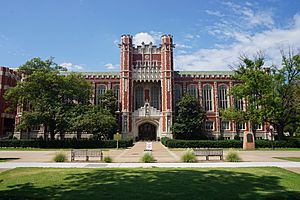
The University of Oklahoma is the largest university in Oklahoma. It has about 30,000 students. The university was founded in 1890, before Oklahoma became a state. It has campuses in Norman, Oklahoma City, and Tulsa. The Princeton Review named it one of its "Best Value" colleges. It is also known for having many National Merit Scholars. Twenty-eight Rhodes Scholars have graduated from the university. The Carnegie Foundation calls it a "highest research activity" university.
The university is well known for its sports teams. They have won many awards, including seven national football championships.
Career and Technical Education
The Moore Norman Technology Center serves Norman. It was established in 1972. The school has won the Oklahoma Association of Technology Center's Gold Star School Award many times. Its main campus has six buildings with over 323,500 square feet (30,000 m2) of space. The school has 207 full-time staff members.
Schools for Kids in Norman
Public Schools
Several public school districts serve Norman. They are separate from other local governments.
Norman Public Schools is the largest district in Norman. It has 15 elementary schools, four middle schools, and two high schools. Over 17,000 students attend schools in this district.
Noble Public Schools serves parts of southeastern Norman. It also serves the cities of Noble and Slaughterville. It has elementary, intermediate, middle, and high schools.
Little Axe Public Schools serves eastern Norman. It has an elementary, junior, and high school.
Other school districts that include parts of Norman are McLoud, Mid-Del, Moore, and Robin Hill.
Private Schools
Several private schools also serve the Norman area:
- All Saints Catholic School (pre-kindergarten through 8th grade)
- Blue Eagle Christian Academy (kindergarten through 10th grade)
- Community Christian School (kindergarten through 12th grade)
- Norman Christian Academy (pre-kindergarten through 7th grade)
- Robinson Street Academy (kindergarten through 12th grade)
- Rose Rock School (pre-kindergarten through kindergarten)
- Terra Verde Discovery School (kindergarten through 5th grade)
- Trinity Lutheran School (pre-kindergarten through 6th grade)
- Veritas Classical Christian Academy (pre-kindergarten through 12th grade)
Media in Norman
The Norman Transcript is the main newspaper in Norman. It is a daily newspaper that covers news in Cleveland and McClain counties. It is the oldest continuous business in Norman. It started on July 13, 1889, shortly after the Land Run of April 1889.
The Oklahoma Daily is a student-run newspaper at the University of Oklahoma. It was first published in 1897. The paper has won many awards for its journalism.
KGOU is a public radio station licensed to the University of Oklahoma. It serves Norman and the greater Oklahoma City area. It broadcasts news, talk shows, and jazz music from National Public Radio and other sources.
Norman TV is a government TV channel on Cox Communications cable channel 20. It shows programs from the City of Norman, including video from city council meetings.
Norman's Infrastructure and Services
Getting Around Norman: Transportation
Airports
For major commercial flights, people in Norman use Will Rogers World Airport in Oklahoma City. It is about 20 miles (32 km) northwest of Norman. Over 3.78 million passengers use this airport each year.
Norman also has Max Westheimer Airport. This is a general aviation airport run by the University of Oklahoma. It can handle executive jet aircraft. It helps reduce traffic at Will Rogers World Airport.
Buses
The Cleveland Area Rapid Transit (CART) provides bus service in the Norman area. It is operated by the University of Oklahoma. CART also offers service to Moore and to Oklahoma City's EMBARK transit hub. CART became the 39th public transportation system in the U.S. to be on Google Transit in 2008. In 2010, CART buses got GPS tracking systems. This lets riders see where buses are and when they will arrive. CART buses carry over 1.3 million travelers each year.
Trains
You can take Amtrak trains from Norman Depot. Amtrak's Heartland Flyer offers daily round trips to downtown Oklahoma City and Fort Worth, Texas.
Norman does not have light rail or commuter rail service yet. However, there is growing interest in adding these services as part of the Oklahoma City metro area's transportation plan.
Roads and Highways
Most people in Norman use roads and highways to get around. About 80.0% of residents drive alone to work. Only 1.3% use public transportation. As of 2007, Interstate 35 carried over 99,000 vehicles daily. Other important highways include State Highway 9 and U.S. Highway 77.
Norman is served by two major federal highways:
 Interstate 35
Interstate 35 U.S. Highway 77
U.S. Highway 77
Norman is served by two major Oklahoma state highways:
Utilities and Services
Electric power in Norman comes from Oklahoma Gas & Electric and Oklahoma Electric Cooperative. Oklahoma Natural Gas provides natural gas. The city's Utility Department offers water, wastewater, and recycling services. They also handle solid waste pickup citywide.
Drinking Water Quality
In 2010, Norman's drinking water had levels of hexavalent chromium that were near the higher end of the acceptable limit. The Garber-Wellington Aquifer was a possible source. Norman's water supply also had higher levels of arsenic. The city responded by building new wells and closing old ones.
Healthcare Services
Norman Regional Health System provides medical services in Norman and central Oklahoma. Its Porter Avenue campus is a 337-bed general hospital. It offers many services, including acute care. In October 2009, the Norman Regional HealthPlex campus opened. It is a 152-bed facility that specializes in cardiology and services for women and children.
Famous People from Norman
Norman's Sister Cities
Norman has four international sister cities. This program helps build understanding between different cultures:
 Arezzo, Tuscany, Italy
Arezzo, Tuscany, Italy Clermont-Ferrand, Puy-de-Dôme, France
Clermont-Ferrand, Puy-de-Dôme, France Colima, Col., Mexico
Colima, Col., Mexico Seika, Kyoto, Japan
Seika, Kyoto, Japan
Images for kids
See also
 In Spanish: Norman (Oklahoma) para niños
In Spanish: Norman (Oklahoma) para niños



